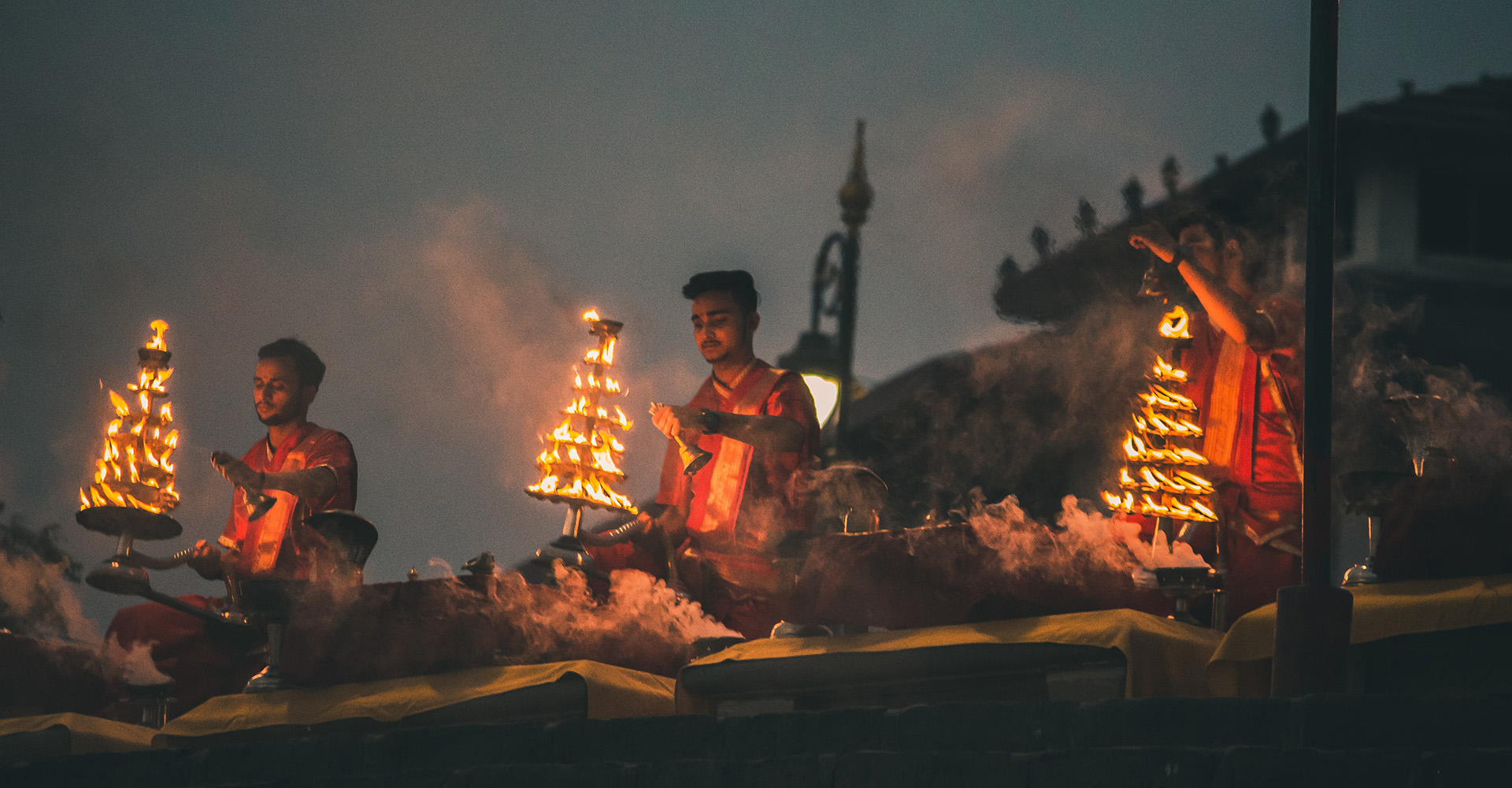Visiting Varanasi (Benares): History, Sunrise, and the Ghats
“Older than history, older than tradition, older even than legend, and looks twice as old as all of them put together.” – Mark Twain, giving his (not entirely inaccurate) description of Varanasi
I felt brilliantly alive from the first moment we arrived in Varanasi. Its sights, sounds, colors, and yes, death, brought me immediately into the present, absorbing me in its endlessly fascinating spectacle of ritual activity. Over the next few days we would come to know the city in a very intimate way, learning what we could about its history and ritual. Here is some of what we learned.
Brief History of Varanasi
The city name, “Varanasi” (also known as Benares, likely a corruption of the name Varanasi), is derived from the two tributaries of the Ganges River — Varuna and Asi — between which it is situated. Historically, the city has been known to the Hindus as Kasha, which means “brightness”, which gives the city its title as the “city of light”. According to Hindu tradition, Varanasi is the oldest city in the world, the eternal city of Shiva. However, to put this in historical perspective, the city was likely settled by the Aryans, as they progressed eastward across the Gangetic plain in the earlier part of the 1st millenium BCE (1000-750 BCE). Although certainly still pretty old, this would make it far younger than the oldest Indian subcontinent civilization, the Harappan civilization (2300-1000 BCE) along the Indus River Valley, which existed simultaneously with the Sumerians in Mesopotamia (2900-1800 BCE) and the Old Kingdom Egyptians (2650-2134 BCE).
Visiting Varanasi: Sunrise on the Ganges River
Hindus have a cyclical view of life and death (death feeds life, and in turn, life feeds death, around and around again); in Varanasi in particular, this cycle is strikingly tangible and omnipresent: birth and death dominate the rituals of daily life. The belief is reinforced by the city’s physical layout: Varanasi is entirely positioned on the west side of the Ganges, the side of the setting sun and therefore symbolic of the city’s association with death as the Hindu cremation center; at the same time, the city faces east, the side of the rising sun, symbolic of rebirth and new life. The east-facing direction of city creates incredible morning light; a sunrise boat ride is a highlight of any visit. Since the city is entirely positioned on the west bank, sunrise boat rides afford the early riser unparalleled, magical, orange-hued views of ritual bathers performing puja (worship) of the rising sun and doing laundry.
The “Burning” or Cremation Ghats in Varanasi
The stone steps (ghats) lining the Ganges — descending from the city, down the riverbank, and into to the river — emphasize the city’s focus on the sacred river. There are over 100 individual ghats in total lining the river’s edge; these steps make access to the river possible during wet (when the river runs high and only a few steps are visible) and dry (when the river runs low and many steps are visible) seasons. As Hinduism’s most sacred city, Hindus arrange (to the extent possible) to die and be cremated in city, whereupon their ashes are left to be carried away by the sacred Ganges river. The cremation fires at these ghats burn 24-hours a day, 7 days a week. Firewood used for cremation: mango tree for common people and sandalwood for rich; apparently, double the weight of the body is required in firewood in order fuel the fire for the three hours it takes to cremate a body. The premier cremation ghat in the city is Manikarnika Ghat, and lies about a 5-10 minutes walk north of the main ghat. No photographs are permitted, for obvious reasons.
Ceremonies at Dashaswamedh Ghat
Ganges ceremonies at sunset are held at the main (Dashaswamedh) ghat. Every day, as the sun sets, multiple Ganges ceremonies begin on the steps of the main ghat. The ceremony consists of bell-ringing (to ward off evil spirits) and offering a series of seven, elaborate gifts of light to the river. The gifts of light get progressively brighter as the ceremony proceeds; it ends by floating candles on the water and pouring water into the Ganges. A definitely memorable experience…
Please note that some of the links above are affiliate links; as an Amazon Associate, Approach Guides makes a commission from qualifying purchases.



 Copyrighted. Please contact info@approachguides.com if you would like to reuse this image.
Copyrighted. Please contact info@approachguides.com if you would like to reuse this image.